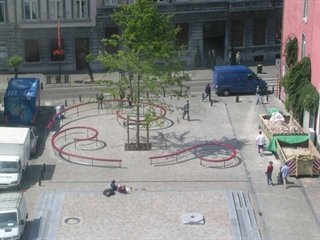ARABESK-PALAVERBOOM
| Part 1. The profile of the example | |
|---|---|
| Location |
|
| Type of open space – uses | Neighbourhood square - a meeting place for local residents |
| Socioeconomic Profile | Lower income, immigrant community |
| Who is responsible for maintaining the open space? | Municipality of Brussels |
| History of the open space | Recyclart-the cultural Centre of Brussels funded the architectural design of an open space in the district of Marolles to create a meeting place for local residents, reflecting the multi-cultural composition of the local community. |
| Objectives | The objective of the project was to promote social cohesion and the creation of a meetingplace in a neighborhood that in recent years significantly changed |
| Results | There have been several misunderstandings between young people and traders in the area: the traders feared that the combined forces of youth, the customers would stay away. |
| At what costs (if known) | Not known |
| Funding Sources | Recyclart-Cultural Centre of Brussels, and Municipality of Brussels |
| Part 2. The sustainability assessment | |
| What are the elements of the place that constitute “best practice” in terms of sustainability? (including views of different stakeholders) | Community meetings, participation of different stakeholders (traders, youth, residents...) and neighbourhood parties were held to prepare the design. The idea of a 'bench' as a meeting point and as a referance to the African culture of meeting under the tree prooved an effective element in enhancing the social cohesion in this neighbourhood. |
| What are the elements of the place that constitute “bad practice”? (including views of different stakeholders) | Not known |
| Who gains and who loses? Economic, social, cultural, environmental costs and benefits. | Both local residents and the municipality. The project is aimed at a local level. |
| How this place has affected the behaviour of inhabitants and users | |
| How this place functions in the wider context of the neighbourhood/ city e.g which area does it serve? Is it connected to other public spaces or services? What its level of accessibility? | Every African village has a tree under which the village elderly take major decisions. It was this image of the palaver tree that the artist Joseph Legrand had in mind when he was commissioned by Recyclart in the Brussels district of Marolles to create a meeting place for local residents. He designed a seating element in arabesque form. |
| Part 3. Public participation | |
| Have the inhabitants participated in the planning/design of the place in any way, invited by the public authorities and planners? | Objective of the project was to promote social cohesion and the creation of a meetingplace in a neighborhood that in recent years significantly changed. Community meetings, participation of different stakeholders (traders, youth, residents, ...) and neighborhood parties were held to prepare the design thoroughly. There have been several misunderstandings between young people and traders in the area: the traders feared that the combined forces of youth, the customers would stay away. The youth wanted no part of their 'clean' furniture that unlike the old banks could no longer tolerate personal scripture. The design of the bank itself embraces the criteria of interest, social encounter and fits into the reconstruction of the square. |
| Have the inhabitants tried unilaterally to influence the design or change some of it? | |
| Has there been a role for community groups, environmental groups or other collective bodies representing the inhabitants or the users of the place? | |
| How do inhabitants of surrounding areas and users treat the place: do they take care of it or not, and what ways | |
| Part 4. Transferability: is the example transferable? | |
| Explain how and why | This project is an example of a small scale art intervention on a very specific local context buth within a global perspective. |
 |
